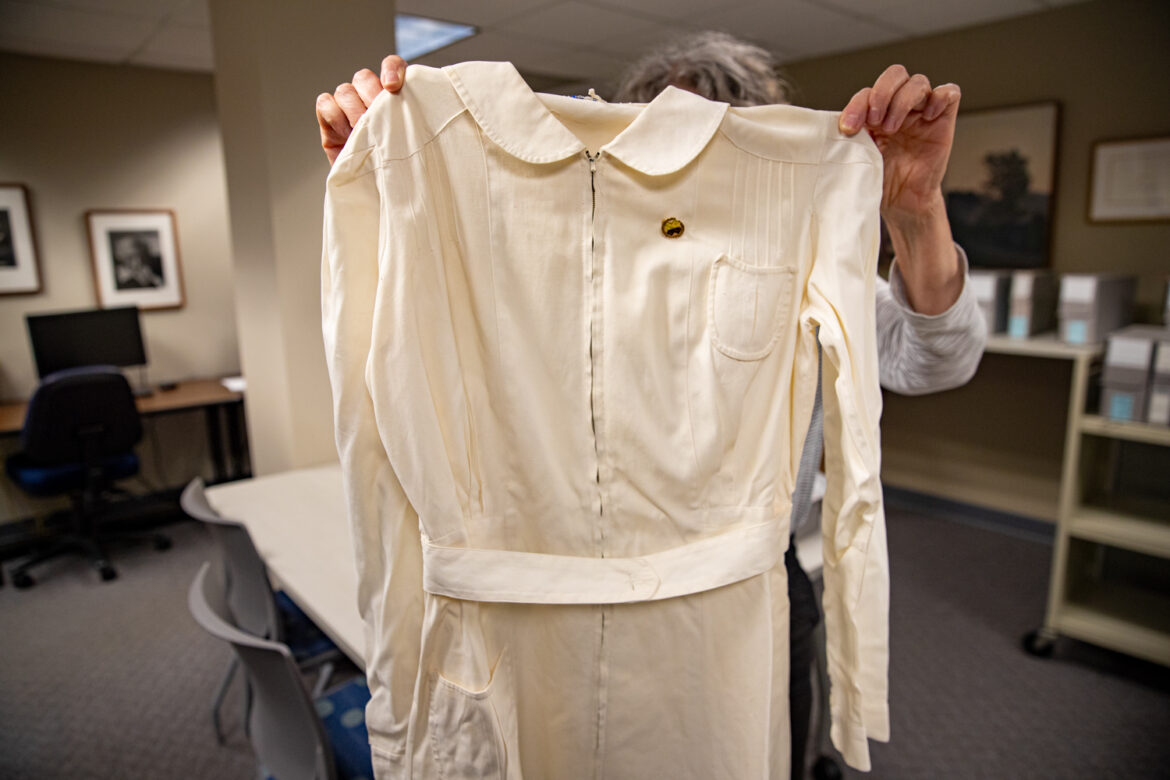This is an installment in a multi-part series.
Deep in the University of Iowa archives, boxes upon boxes line the shelves of vast rooms. Each box files into a specific archive. In the Women’s Archives, an assortment of cardboard boxes lay stacked high.
Within one of these boxes is a long glass tube from the 1750s, both sides open with one for suction and one for the mouth with a little glass bulb in the middle. One of the few things known about the tube is that it is, for all intents and purposes, a manual breast pump. Archivist Anna Holland works within the women’s archives and considers the pump one of the most mysterious items in the archives.
The Daily Iowan: When was the item acquired?
Holland: I wasn’t here when we got it, but we’ve got this folder about it. It came from the UI College of Nursing, and it was given to them in 1974. So it probably would’ve come to the university’s Women’s Archives shortly after we opened in the 1990s, and the college’s records were transferred here.
Is there anything in the files that says who could have possibly used the item?
We don’t know who used it. It was for sale in New Orleans, so I assume somebody from there did. It was given to Rozella M. Schlotfeldt in the 1940s. She said a faculty member at her school, Blanche McGurk, gave her this breast pump or pipe, ‘in recognition of my interest and involvement in maternity nursing.’ She was, at that point, a faculty member at the UI.
I think the idea that it may have also been called a pipe suggests perhaps the long arm was to reach the mouth to create suction and bring the milk into the bulb.
It might be for a wet nurse, someone who couldn’t be around the baby, or for some reason the mother couldn’t be around or wasn’t around anymore.
In your archives, are there any possible references to this item or something like it?
Obviously, in women’s correspondence, they talk about their children and having babies around, but normally, the correspondence doesn’t get into the intimate details. I would say it’s very likely you could find something about it in another archive.
In any possible reference to lactation, is it usually breastfeeding or formula?
Yes, though the formula portion wouldn’t come out until the 17th century.
In an effort to understand if students would have used this item to study from, Holland took a new box out of the archives: an old university nursing uniform.
“Student Uniform — 1928.” We have her starched cuffs and her pin. This is her nice cotton uniform. We’ve got a nice Peter Pan collar and a zipper. When we see it, you can imagine putting it on every day and wearing it all day.
She would’ve been wearing it with hose and high heels. She would’ve been pinning the cuffs on her sleeves.
What do you mean by starching? Was there a specific way they would wash these?
These used to be starched in the past, and it’s a way to keep them stiff.
Men would wear starched collars that were stiff around their necks like this [the uniform cuffs]. It keeps its shape even with the sweat. So the collar would’ve been separate from the shirt.
This is then wrapped in some acid-free tissue.
A lot of paper has some acid in it; a little bit is a part of the making process. With something permanently stored like this, that can cause some damage.
Do you think the pump was used to educate the students?
If it were a part of the Heritage Room, they could’ve seen it. But seeing as they themselves didn’t know much about it, I don’t know what it would’ve been able to tell them beyond ‘people were doing this.’
I could see it being of interest, especially to women who are working in the infants’ ward.
What are some key differences between a modern breast pump and this one?
It’s harder to clean, but that’s part of it. Mine is mechanized, but there are modern breast pumps that work more on suction. But the flange is small on the 1750s one.
So if you’re going to put it on your nipple, it’s not going to be pumping from the whole breast. This is not, I think, as effective. Which would explain the smaller bulb here because it’s not going to be getting much out.


Dining and Cooking